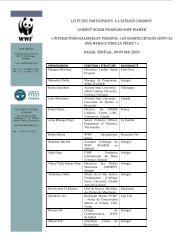Little Fish, Big Impact Summary - Lenfest Ocean Program
Little Fish, Big Impact Summary - Lenfest Ocean Program
Little Fish, Big Impact Summary - Lenfest Ocean Program
You also want an ePaper? Increase the reach of your titles
YUMPU automatically turns print PDFs into web optimized ePapers that Google loves.
Under<br />
water<br />
Main Findings<br />
Forage fish are vulnerable<br />
They can rebound rapidly in some cases but have biological and<br />
ecological characteristics that make them vulnerable to overfishing.<br />
They fluctuate…<br />
Forage fish abundance is highly variable, often unpredictable,<br />
and sensitive to changes in environmental conditions.<br />
Peruvian anchoveta<br />
North/Central stock, in metric tons<br />
20<br />
15<br />
10<br />
5<br />
1925 ’35 ’45 ’55 ’65 ’75 ’85 ’95 2005<br />
…and are easily caught,…<br />
Above<br />
Because water they form dense schools—<br />
often called “bait balls”— forage fish<br />
are easily caught, even when their<br />
abundance decreases.<br />
…making them vulnerable to collapse.<br />
<strong>Fish</strong>ermen might therefore be able to scoop up large numbers<br />
of forage fish during a natural population decline, greatly<br />
compounding that decline. Indeed, several forage fish populations<br />
collapsed in the 20th century, and the Task Force’s analyses suggest<br />
conventional management could lead to more collapses.<br />
Task Force analysis showed many forage species<br />
collapse, even at relatively low catch rates.<br />
Results of the Task Force’s model simulations of a strategy of<br />
constant yield (tonnage). Model tested seven catch levels on 30<br />
species. Historically, a catch level of 1.0 was considered sustainable.<br />
Percent of of species species remaining not collapsed<br />
100%<br />
60%<br />
*Simulations were not run<br />
for levels 0.35, 0.40 and 0.45.<br />
20%<br />
*<br />
0.05 0.10 0.15 0.20 0.25 0.30 0.50<br />
Catch level (fraction Catch level of unfished (fraction biomass of maximum times unfished natural biomass) mortality rate)<br />
4<br />
Forage fish are<br />
valuable as prey<br />
Many predators are highly<br />
dependent on forage fish...<br />
chinook<br />
Salmon<br />
…and decline when<br />
forage fish decline.<br />
Modeling by the Task Force found that the more<br />
a predator’s diet relies on forage fish, the more its<br />
population declines when forage fish decline.<br />
Globally, forage fish have<br />
greater monetary value as prey.<br />
The Task Force compared the global value of<br />
the direct catch of forage fish with the value of<br />
allowing them to remain in the ocean as prey for<br />
other commercially valuable fish.<br />
Economic importance of forage fish<br />
tOtaL $16.9 BiLLiON<br />
Direct value Supportive value<br />
of commercial<br />
forage catch<br />
$5.6<br />
billion<br />
Humboldt<br />
penguin<br />
Southern<br />
giant petrel<br />
Humpback<br />
Whale<br />
of forage fish to other<br />
commercial catch<br />
$11.3 billion



